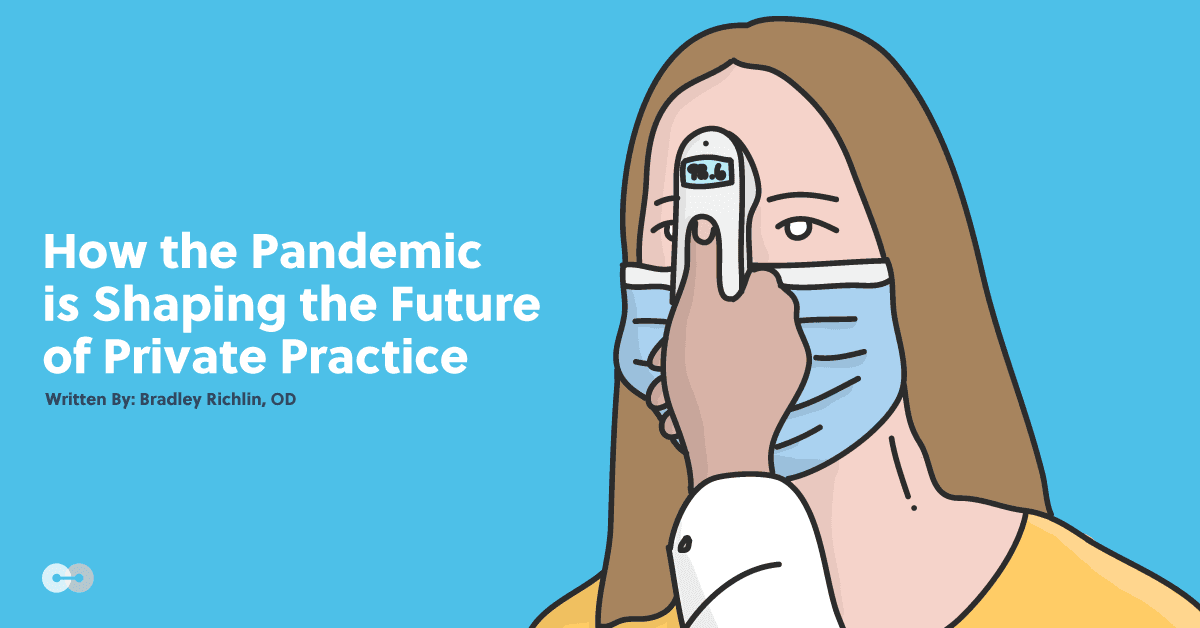The COVID-19 pandemic has challenged us all to do things differently—including private practice owners, who are rethinking their workflows, focusing on the patient experience, and turning to tech. In this article, we’ll take a look at some of these changes, and how they can help owners stay competitive in a post-pandemic, technology-focused market.
Embrace innovation
As private practice partners, COVID-19 is forcing us to reevaluate how we run our businesses. It’s not about simply moving to telemedicine—with many major players entering the telehealth field and providing basic services, trying to compete in the same way will be a race to the bottom and dilute what makes you and your practice special. Instead, think through how you can make patients feel safe and cared for, and try new tools that allow you to implement different protocols.
At Richlin Eye & Associates, we’ve adopted a zero-wait policy and what I call an “OpenTable mentality.” Our patients fill out all of their paperwork either at home via the website or on an iPad in the office.
We’re working on an app that will allow patients to check in virtually. The idea is that patients will use the app to fill out all of their paperwork ahead of time, and the app will let them know if they’re missing anything. Once they’ve checked in, the app will page them when their exam room is ready. They can take a walk, hang out in their cars—whatever they like—and when they’re paged, they come in with their phones buzzing like a restaurant notified them that their table is ready, and our team takes them back right away.
This has enabled us to not only increase safety but also provide exceptional, quick service, with an average waiting room time of only three minutes and 40 seconds. The future of our waiting room is that we won’t have one at all.
Adjust workflows
Social distancing has provided us with a nearly perfect template for efficient staffing. Since I can’t have my staff sitting next to each other all day anymore, we looked at what each team member was doing each day and swapped tasks based on different work hours. That led to better cross-training. After COVID, we’re not changing anything. We’ll use the things we’ve learned to trim the fat.
We also expanded our hours in order to facilitate social distancing, and have found that work expands to the time allowed. My team is now filling more appointments than ever before, and just having our schedule be full for 12 straight hours has meant a lot to our practice. Our patients also love it, because they can get an appointment on a Sunday afternoon or after work on a weekday.
Sell the clean experience
Another thing that’s critically important right now is to demonstrate that you’re taking cleanliness and safety seriously. At our office, that involves sanitizing stations, staff changing gloves constantly, frames cleaned with UV light, automatic body temperature checks when a patient steps out of the elevator, EnviroKlenz air purifiers—all of these measures that may seem over the top, but go a long way in building trust. Patients will tell us that we “blew them away” with our cleanliness standards, and that gives our staff an opening to ask about sharing their experience with their friends and family.
Replacing a patient with a patient is our philosophy. When a patient comes in and is delighted by everything we’re doing, we’ll inquire as to whether their kids, their spouse, etc., need to be put on the schedule for their annual exam. Providing a comfortable experience for your current patients—an experience that they’ll feel good about sharing with their loved ones—is much more effective than a postcard in the mail will ever be.
Focus on patients’ current realities
We’re living in a time when asking patients how it’s been going since you saw them last year doesn’t make as much sense as it used to. We know how it’s going. We’re all at home more, watching too much TV. We’re all in this mess. And so I’ve taken to acknowledging that and connecting that way. By being in touch with the realities that everyone is dealing with, you can better serve your patients and point them toward products that can help.
For example, people are spending more time in front of their computer screens right now, and so we’re educating patients about blue light blocking glasses like Eyezen, dry eye treatments, and other products that fit our new lifestyles. One of our doctors even found details online about office ergonomics (how high your monitor should be in relation to your line of sight, etc.), and we’ll sometimes provide that information to people who work at home. We want to be the experts in what our patients are dealing with because we want them to have an over-the-top experience.
CovalentCareers is committed to supporting optometrists and optometry students during the Coronavirus pandemic. For more optometry-specific resources and information, visit our Optometry COVID-19 Resource Center.
An opportunity for service
For my practice (and, I’m sure, many others) COVID has turned us into a lean, mean, fighting machine. The lessons we’ve learned and the changes we’ve made will help us continue to compete in the ever-changing world of eyecare. Private practice ODs shouldn’t see this as a time to make a quick switch to out-of-the-box telehealth solutions, but as an opportunity to provide service-based experiences, tap into new technology, and find efficiencies that will serve us—and our patients—in the long run.
